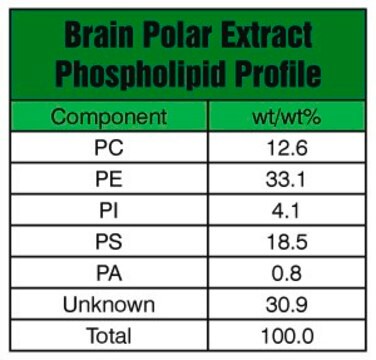추천 제품
양식
powder
포장
pkg of 1 × 1 g (100600P-1g)
pkg of 1 × 100 mg (100600P-100mg)
pkg of 5 × 100 mg (100600P-500mg)
제조업체/상표
Avanti Research™ - A Croda Brand
지질 유형
lipid extracts
배송 상태
dry ice
저장 온도
−20°C
일반 설명
This product is an extract of E. coli B (ATCC 11303) grown in Kornberg Minimal media at 37°C and taken at 3/4 log growth phase. Total E. coli lipid extract is a chloroform:methanol extract of the respective tissue. This extract is partitioned against deionized water and the chloroform phase is concentrated. Polar lipid extract is the total lipid extract precipitated with acetone and then extracted with diethyl ether.
애플리케이션
E. coli Extract Polar has been used for the preparation of lipid standards for validation purposes. It has also been used for determining the molar percentages of lipids.
E. coli Extract Polar has been used:
- in liposome preparation for spectroscopy studies using fluorescent membrane dye, laurdan
- in multilamellar vesicles generation
- as standard lipid material for tandem mass spectrometry analysis
E. coli Extract Polar is suitable: to prepare lipid standard material by dissolving in methanol to prepare small unilamellar vesicle to prepare liposomes (in Tris-hydrochloric acid (HCl)
생화학적/생리학적 작용
E. coli Polar lipid extracts are useful for reconstituting membrane proteins. The phosphatidylethanolamine is the predominant lipid component of E. coli extract polar extract. The minor components include the phosphatidylglycerol (PG) and cardiolipin. These lipids are majorly derived from the leaflets of cytoplasmic membrane and inner leaflet of outer membrane. E. coli polar lipid extracts form bilayer by vesicle fusion.
포장
5 mL Clear Glass Sealed Ampule (100600P-100mg)
5 mL Clear Glass Sealed Ampule (100600P-500mg)
60 mL Amber Wide Mouth Screw Cap Glass Bottle (100600P-1g)
법적 정보
Avanti Research is a trademark of Avanti Polar Lipids, LLC
또한 이 제품과 함께 일반적으로 구입
제품 번호
설명
가격
Storage Class Code
11 - Combustible Solids
가장 최신 버전 중 하나를 선택하세요:
이미 열람한 고객
Assessing Membrane Fluidity and Visualizing Fluid Membrane Domains in Bacteria Using Fluorescent Membrane Dyes
Wenzel M, et al.
Bio-protocol, 8(20) (2018)
Using supported bilayers to study the spatiotemporal organization of membrane-bound proteins
Methods in Cell Biology, 128, 223-241 (2015)
Molecular model for the solubilization of membranes into nanodisks by styrene maleic acid copolymers
Scheidelaar S, et al.
Biophysical Journal, 108(2), 279-290 (2015)
Assessing membrane fluidity and visualizing fluid membrane domains in bacteria using fluorescent membrane dyes
Wenzel M, et al.
Bio-protocol (2018)
Masaru Sasaki et al.
The Journal of biological chemistry, 294(49), 18898-18908 (2019-10-31)
Bacterial membrane proteins are integrated into membranes through the concerted activities of a series of integration factors, including membrane protein integrase (MPIase). However, how MPIase activity is complemented by other integration factors during membrane protein integration is incompletely understood. Here
자사의 과학자팀은 생명 과학, 재료 과학, 화학 합성, 크로마토그래피, 분석 및 기타 많은 영역을 포함한 모든 과학 분야에 경험이 있습니다..
고객지원팀으로 연락바랍니다.









